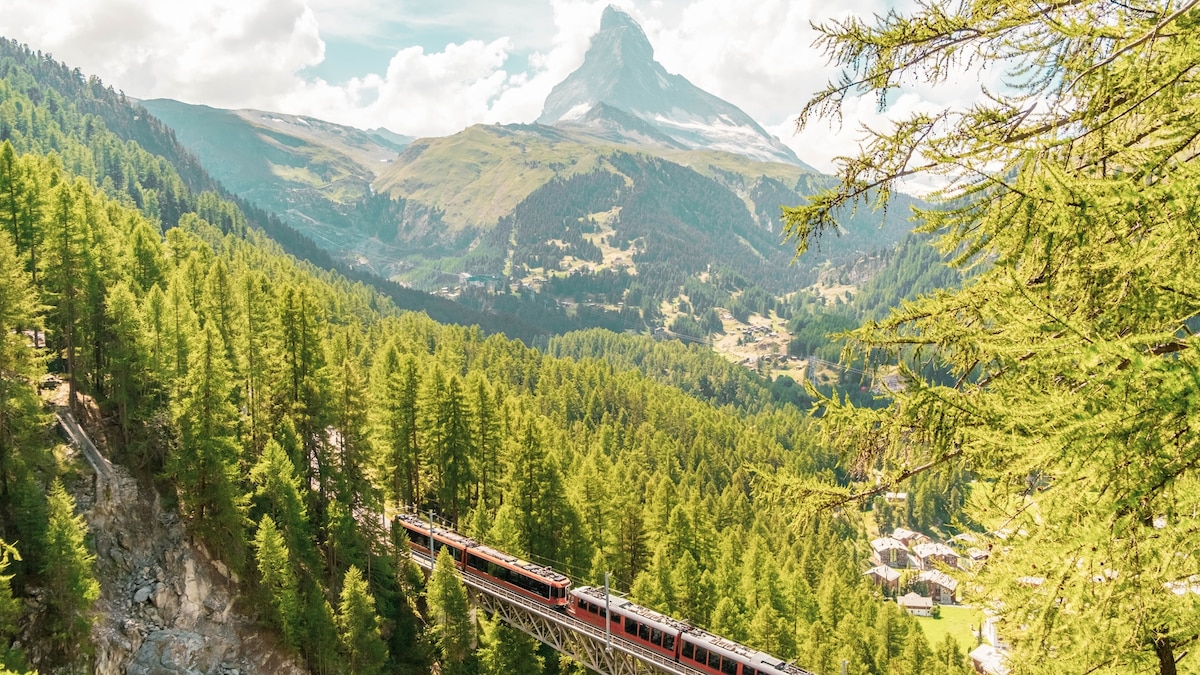
Once a year, the Switzerland’s federal rail operator SBB (Schweizerische Bundesbahnen) reconfigures the country’s Switzerland’s train schedule. And every year, it becomes front page news across the tiny alpine nation, in all four languages, of course. With more than 3,200 miles of tracks, Switzerland’s matrix of a rail network is not only the world’s densest per area, but Swiss law stipulates that public transport must connect every single town and alpine village.
And fortunately for both residents and travelers, whatever isn’t connected by train, is connected by lake steamers, post buses, funiculars, gondolas, and other modes of transport, often waiting for you after you exit the train platform.
There are no high-speed trains in Switzerland, but that’s precisely what makes rail travel here special. Slow travel may be in vogue today, but in the Alps, it’s long been a necessity with giant massifs, ravines, glaciers, and waterfalls, making for some very precarious engineering and track work. But what makes Swiss rail travel extraordinary is the breathtaking alpine landscape you traverse through.
Even a short 30-minute journey can hurtle you past cerulean lakes, ancient glaciers, primordial forests and chic snow-ladden ski slopes, all visible from the comfort of your seat. Switzerland’s railway system is so epic that it’s even home to a UNESCO World Heritage Rail Route, the iconic red Rhätische Bahn, as much of an engineering feat today as it was when workers painstakingly built its 383 bridges and 84 tunnels over a century ago in 1888.
But with 9,000 trains operating every day on Swiss rails, how do you know which routes are the best? We asked rail expert Everett Potter, author ofNational Geographic’s 100 Train Journeys of a Lifetime, scheduled to publish on October 7, 2025, to tell us his favorites. All aboard for Switzerland’s marvelous and scenic trains.
1. Glacier Express
Best for: Food lovers
Route: Zermatt (Canton Valais) to St. Moritz (Canton Graubünden)
Journey time: Eight hours
Distance: 186 miles
While Switzerland’s regular passenger train routes are some of the country’s most beautiful, the Glacier Express, a scenic tourist line, is not only picturesque but hands down the longest. The eight-hour journey runs between Zermatt, with its postcard views of the snaggle-toothed Matterhorn and the fashion-forward ski mecca of St. Moritz. “The Glacier Express is a Swiss train set come to life,” says Everett Potter.
“Dubbed ‘the slowest express train in the world, the narrow-gauge train is an eight-hour odyssey burrowing through 91 tunnels and over 291 bridges along the way, passing lush valleys, snow-dusted peaks, remote Alpine hamlets, and towering stone viaducts. When it debuted in 1930, it was a radical concept: a train that existed solely for sightseeing on a carefully planned route showcasing the country’s very best.”
Today, visitors can splurge on the train’s Excellence Class carriages, equipped with plush white leather seats, glass-domed ceilings, and e-tablets loaded with interactive maps highlighting local towns, such as Niederwald and neighboring Ritzegen, the birthplace of the famous Swiss hotelier César Ritz (1850-1918).
Perks, quite ritzy themselves, include red carpet champagne arrivals with crystal flutes, an old-fashion rattling bar car filled with rare whiskeys and local wines that complement the onboard five-course meals: think mint pea soup with Gruyere double cream and braised Simmental beef—what better way to cross the Oberalp Pass at 6,706 feet—the trip’s highest point.
(All aboard the Glacier Express, from Zermatt to St Moritz)
2. Bernina Express
Best for: Glacier hikers
Route: Chur (Canton Graubünden) to Tirano, Italy (Lombardy)
Journey time: Four hours
Distance: 76 miles
“For train fanatics, the Bernina Express ranks very high,” states Potter. “It’s packed with glaciers, snow-capped mountains, dense forests, and alpine meadows.” The journey, from Chur to the Italian town of Tirano, is part of the UNESCO World Heritage Rhaetian Railway, one of five trains in the world to bear the designation.
It’s a normal passenger train, easily taken in segments, like the “leg from St. Moritz to Poschiavo, an Italian-speaking Swiss village near the Italian border, with return the same day.” In the summer, the train operates open-air convertible train cars, allowing travelers to truly absorb sights, sounds, and smells of the Alps.
“The Bernina Express is not a cog railway but a narrow-gauge train,” adds Potter. “The peak of the journey is 7,391 feet above sea level at Ospizio Bernina, the highest crossing of any train in the Alps without the benefit of a tunnel.”
On the ascent, visitors can stop at the Diavolezza Gondola, which whisks them up 10,000 feet to Piz Bernina, where they can ski, hike its paths, or get up close to the Pers and Morteratsch Glaciers with the right gear. As the train begins its descent, a brief stop allows you to exit at the tiny Alp Grüm station, which “has commanding views of the rapidly melting Roseg Glacier.”
3. The GoldenPass Express
Best for: Romantics
Route: Montreux, Lake Geneva (Canton Vaud) to Interlaken (Canton Bern)
Journey time: Three hours 15 minutes
Distance: 71 miles
Launching in 2022, this scenic tourist train chugs its way from the sun-kissed shores of Lake Geneva on the French-speaking Swiss Riviera to the rugged alpine heartland of Swiss German speaking Canton Bern. This route passes by century old vineyards, hill-perched castles, and villages like Château-d’Œx, famed for its hot air balloons.
According to Potter, “The train is outfitted with floor-to-ceiling windows treated with anti-reflective technology, ideal for photography.” Several different Golden Pass Trains run on this route, including the wood-paneled Belle Époque cars with brass trim and turquoise velvet brocade seats, recalling a bygone era of rail travel.
“This locomotive is especially eye-catching,” he says. “Little surprise since it was created by the Italian design firm Pininfarina, best known for its work with Ferrari and Maserati.”
(The inside guide to Lausanne, Switzerland’s newest cultural center)
4. Gornergrat
Best for: High-altitude hikers
Route: Zermatt (Canton Valais) to the Gornergrat summit (Canton Valais)
Journey time: 44 minutes
Distance: Six miles
The Gornergrat begins its “short but memorable climb” in the heart of the Swiss resort town of Zermatt before winding its way up to the Gornergrat Station at 3,089 meters (10,170 feet). “Remarkably, this train line has been open since 1898 and climbs up 4,900 feet from Zermatt, the second-highest railway in Europe, after the Jungfraubahnen,” says Potter. “It’s also the highest open-air railway on the continent.”
Clear days offer fine views of the Hornli Hut on the flanks of the Matterhorn, the lodge where climbers spend the night before continuing onward to the peak. And at the top of the Gornegrat, you’ll often encounter St. Bernard dogs, and alpine horn players. The route also offers a panoramic view of over thirty 13,000-plus feet high peaks, including the Weisshorn, Castor, Pollux, and the Dufourspitz the highest point in Switzerland and part of the Monte Rosa massif). Don’t miss the panoramic views of the Gornergletscher, the third-largest glacier in the Alps.
(Six of the world’s best mountain-rail trips)
5. Gotthard Panorama Express
Best for: Boat enthusiasts
Route: Lucerne (Canton Lucerne) to Lugano (Canton Ticino)
Journey time: Five hours 30 minutes
Distance: 113 miles
When the 35 mile long Gotthard Base Tunnel opened in 2016, it made headlines as the world’slongest and deepest railway tunnel. But it also left behind an infrastructure of spectacularly scenic rails through the mountains. In the alpine tradition of never throwing away something useful, the Gotthard Panorama Express operates on these disused tracks.
“Starting in Lucerne, one of Switzerland’s most beautiful cities, this trip begins not with a train ride but with a leisurely voyage on a vintage paddlewheel steamer across Lake Lucerne, one of the country’s most beautiful lakes,” says Potter. “It then connects to the Gotthard Panorama Express train, which runs down to Lugano in the Italian-speaking Canton of Ticino, through the dramatic center of the Alps.”
The journey not only combines scenic landscapes with railroads and steamships but crosses a linguistic and cultural threshold linking one of the most beautiful cities in German-speaking Switzerland with its counterpart in the south, where pines are replaced by palms and Switzerland adopts a heaping of “la dolce vita.”
6. Jungfraubahnen
Best for: Mountain Lovers
Route: Kleine Scheidegg to Jungfraujoch – Top of Europe (Canton Bern)
Journey time: 35 minutes
Distance: Five miles (plus a 4,593-foot ascent)
“You can’t get any higher on a railway line in Europe than the Jungfraubahnen,” says Potter. “This is a trip to the top of the Bernese Oberland in the Alps, and the lair of the peaks known as the Eiger (13,025 feet), Monch (13,465 feet), and Jungfrau (13,642 feet)—the Ogre, the Monk, and the Virgin,” he explains.
Visitors can hop aboard a train from Interlaken to the Eiger Glacier station or Kleine Scheidegg station, or board the new Eiger Express triable gondola at Grindelwald Terminal to reach the start of the Jungfrabahn. The train burrows deep inside Eiger and Monch mountains for more than four miles before emerging at the Jungfraujoch, a high mountain pass at 11,333 feet.
“The vantage point offers spectacular views of Europe’s largest glacier, the UNESCO-listed Aletsch Glacier, spanning over 14 miles in length.” The iconic Sphinx Observatory sits at the top, looking like a villain’s lair in a Bond movie, according to Potter.
7. Centovalli Express
Best for: Geography buffs
Route: Locarno, Switzerland to Domodossola, Italy
Journey time: Two hours
Distance: 32 miles
Expect to be dazzled by the 100 valleys of the namesake Centovalli Express, which winds its way from Locarno (on the sparkling shores of Lake Maggiore in the Italian-speaking canton of Ticino) to the mountain town of Domodossola in Piedmont, Italy, beloved for its bustling Saturday market.
Potter says, “The easy round-trip excursion offers a scenic tour of waterfalls, gorges, lakes, and valleys, and remains a hidden gem among Swiss train rides.” The train crosses 83 bridges and whisks through 34 tunnels all the while bypassing vine-covered slopes and secluded villages where campanile bells echo through the woods.
But the highlight for many railway fanatics is crossing the 285-foot-high Isorno Bridge, completed in 1923. The steel deck arch railway viaduct with its reticulated metal arch spans across the Isorno River and the deep gorge below.
“Those deeply forested gorges with groves of wild chestnut and beech trees are more than merely scenic — this train follows the divide between the European and African continental plates,” explains Potter.



